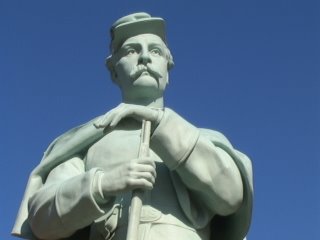
There are three ways to make a war (or any other) memorial effective.
1) Put it on the site of the event it commemorates
2) Use materials from some object that was involved in the event
3) Make a great or thought-provoking piece of art that can stand on its own merits.
I’ve been following the stories of 9/11 monuments and will be dedicating the next few blogs to them. This is a big deal, this memorializing the 9/11 Twin Towers attacks. And because it’s such a big deal, it’s provoking a lot of heated responses. And it’s bound to spawn schlock and crappy monuments.
Which reminds me a lot of the Civil War.
We’ve all seen the ubiquitous tin soldiers that mushroomed after that internecine disaster. Cute, in their easily recognizable uniforms. Every town in the nation seems to have one, no matter how small. But aside from pranksters who dress these guys up on holidays, or deface their pedestals, or the random tourist who finds the piece a great free photo op (especially in the South) nobody pays any attention to them.
Let me tell you a story about them.
The Civil War touched the whole nation, winner or loser. Everyone had lost someone they knew to the conflict. Sort of like the current battle of the reds and blues- only plus blood. The wounds were raw. Everyone wanted to honor the dead, the dying, the wounded and maimed and the guys who fought for the hometown cause. They wanted to be reminded of it every day. And they wanted coming generations to be reminded of it as well. So they raised memorials. Big ones. Small ones. Granite and marble and bronze and tin.
People were encouraged in this by three big things.
1) The “City Beautiful” movement. Started around the time of the Chicago World’s Fair in 1893, it decreed that every town and city in the nation should strive to add decoration to its plain jane streets and make it gorgeous- like France, for example.
2) Prosperity in the North. Although the south had to scratch and scrape to raise its memorials, the North had the dough to shell out for statues and arches and towers and reliefs.
3) Savvy businessmen who could smell a gravy train when it chugged by. Foundry and quarry salesmen cruised the countryside with sample cases full of drawings of statues fit for any budget. And that included massed produced tin soldiers.
By the time WWI turned up, city Arts Commissions prepared themselves for the new onslaught they knew was coming. They decried the tragic waste of money the last war had bought and issued guidelines in creating new pieces. But that’s another story…
So now we come to 2006. The fifth anniversary of the Big Event of our generation. And here come the monuments…
(To be continued…)
